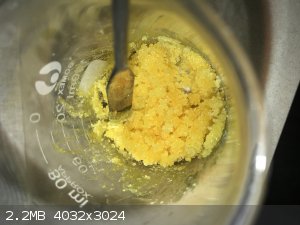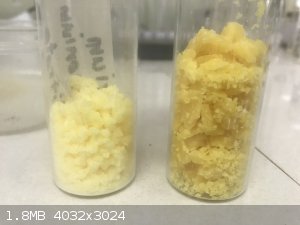| Pages:
1
2 |
elementcollector1
International Hazard
    
Posts: 2689
Registered: 28-12-2011
Location: The Known Universe
Member Is Offline
Mood: Molten
|
|
When CeAN melts, does it do so without hazards? (I'm thinking of detonation due to the 'ammonium nitrate' present, decomposition of the substance,
toxic gases, etc.)
If it doesn't, given Wiki's listed MP of 108 C, this could be a viable route to cerium metal, through molten electrolysis or otherwise.
Elements Collected:52/87
Latest Acquired: Cl
Next in Line: Nd
|
|
|
Lion850
National Hazard
   
Posts: 517
Registered: 7-10-2019
Location: Australia
Member Is Offline
Mood: Great
|
|
Today I made cerium ammonium nitrate. As it boiled down the solution was deep orange and I expected orange crystals. Once crystals started to form the
color was lighter but still orange while wet. It must have been boiling off its water of hydration because as the beaker cooled the crystals became
rock hard and changed color to a nice yellow. I suppose the color varies between orange and yellow depending on amount of included water?

|
|
|
Texium
Administrator
       
Posts: 4659
Registered: 11-1-2014
Location: Salt Lake City
Member Is Offline
Mood: Preparing to defend myself (academically)
|
|
CAN is never yellow like that. Anhydrous CAN is a deep red-orange. The only reference to a hydrated species that I could find was the mention of a
(NH4)2[Ce(NO2)5(H2O)2]•2H2O on Wikipedia, but its appearance is not
described, and since it contains water ligands and one fewer nitrate ligand, it’s a fundamentally different compound, and probably doesn’t exhibit
the same useful properties as CAN. Other Ce(IV) compounds are yellow though. You may have overheated it and produced basic cerium(IV) nitrate. Try
redissolving the yellow stuff in nitric acid and adding more ammonium nitrate.
[Edited on 2-26-2020 by Texium (zts16)]
|
|
|
Lion850
National Hazard
   
Posts: 517
Registered: 7-10-2019
Location: Australia
Member Is Offline
Mood: Great
|
|
Hi Texium - quite a few places online mention the color as yellow to orange, and a picture search shows samples with similar yellow color. Mine was
still orange when a wet paste, and only turned yellow when it reabsorbed the water as it cooled.
I’ll try a second batch when I have more reagents ready, and dry it in the desiccator from when it is a deep orange solution.
|
|
|
AJKOER
Radically Dubious
    
Posts: 3026
Registered: 7-5-2011
Member Is Offline
Mood: No Mood
|
|
Some interesting comments at this ScienceDirect source (see https://www.sciencedirect.com/topics/chemistry/cerium ):
Some extracts:
"An easy and low-cost method, widely used for the obtention of aqueous suspensions of CeO2NPs, consists of the precipitation of cerium salts at basic
pH. Briefly, oxidation of the Ce3 + ions from Ce(NO3)3 salt at basic pH conditions to the insoluble species Ce4 + using hexamethylenetetramine (HMT).
During precipitation, CeO2 nanocrystals are formed and can further stabilize in aqueous medium with the same reagent HMT, that form the double
electrical layer to prevent agglomeration [64]. Other basic reagents usually employed are urea, NH4OH and TMAOH [65]."
And:
"Further applications of the element include its use in zinc-cerium redox flow batteries [34]. These batteries function based on the generation of
electricity in the presence of Ce4+ during the charge phase, or reduction reactions through the oxidation of zinc, which produces about 2.43 V [35]. A
major component of these batteries is the electrolyte (i.e., methanesulfonic acid), which easily dissolves cerium compounds [36]. Ce4+ is produced
through electrical driving forces that are used in the electrosynthesis of naphthoquinone [37]."
[Edited on 27-2-2020 by AJKOER]
|
|
|
Texium
Administrator
       
Posts: 4659
Registered: 11-1-2014
Location: Salt Lake City
Member Is Offline
Mood: Preparing to defend myself (academically)
|
|
Quote: Originally posted by AJKOER  | Some interesting comments at this ScienceDirect source (see https://www.sciencedirect.com/topics/chemistry/cerium ):
Some extracts:
"An easy and low-cost method, widely used for the obtention of aqueous suspensions of CeO2NPs, consists of the precipitation of cerium salts at basic
pH. Briefly, oxidation of the Ce3 + ions from Ce(NO3)3 salt at basic pH conditions to the insoluble species Ce4 + using hexamethylenetetramine (HMT).
During precipitation, CeO2 nanocrystals are formed and can further stabilize in aqueous medium with the same reagent HMT, that form the double
electrical layer to prevent agglomeration [64]. Other basic reagents usually employed are urea, NH4OH and TMAOH [65]."
And:
"Further applications of the element include its use in zinc-cerium redox flow batteries [34]. These batteries function based on the generation of
electricity in the presence of Ce4+ during the charge phase, or reduction reactions through the oxidation of zinc, which produces about 2.43 V [35]. A
major component of these batteries is the electrolyte (i.e., methanesulfonic acid), which easily dissolves cerium compounds [36]. Ce4+ is produced
through electrical driving forces that are used in the electrosynthesis of naphthoquinone [37]."
[Edited on 27-2-2020 by AJKOER] |
Please explain how this is the least bit relevant to this thread.
|
|
|
Lion850
National Hazard
   
Posts: 517
Registered: 7-10-2019
Location: Australia
Member Is Offline
Mood: Great
|
|
I made another batch which I reduced in volume on a steam bath and then when it was a wet pale orange paste the desiccator under vacuum. Again, the
color lightened as it dried but it did end up a bit more orangy. See photo comparing the two batches.
This site mentions that the tetrahydrate is white.
https://www.americanelements.com/cerium-iii-ammonium-nitrate...

|
|
|
woelen
Super Administrator
        
Posts: 8060
Registered: 20-8-2005
Location: Netherlands
Member Is Offline
Mood: interested
|
|
Keep in mind that cerium exists in two oxidation states. Cerium(III) is colorless, cerium(IV) is yellow/orange. Cerium(III) salts hence will be white.
|
|
|
Texium
Administrator
       
Posts: 4659
Registered: 11-1-2014
Location: Salt Lake City
Member Is Offline
Mood: Preparing to defend myself (academically)
|
|
Yeah at best here you probably have a mixture of Ce(IV) and Ce(III). Could you please post the exact procedure that you used to make this, since your
product looks so different than what others posted upthread?
|
|
|
Lion850
National Hazard
   
Posts: 517
Registered: 7-10-2019
Location: Australia
Member Is Offline
Mood: Great
|
|
Woelen, Texium:
I had available Ammonium Carbonate, Cerium (iii) nitrate, and 70% nitric acid. All LR grade. The ammonium carbonate and cerium (iii) nitrate are both
while/clear crystals. I used this equation:
1Ce(NO3)4.6H2O + 2NH4NO3 = 1(NH4)2Ce(NO3)6 + 6H20
My app does not accept Ce(NO3)3 as input which was a problem. I decided to use the same quantities as nitic acid would be in excess and I hope the
nitric acid would kick the cerium (iii) to cerium (iv).
I made ammonium nitrate by reacting 29g of the ammonium carbonate (which have the formula on the bottle as NH4HCO3.NH2COONH4, I assume this is to keep
it stable) with 50g 70% HNO3.
NH4HCO3NH2COONH4 + 3 HNO3 = 3 NH4NO3 + 2 CO2 + H2O
This should have given me 44g ammonium nitrate in solution.
One fitth of the ammonium nitrate solution was poured off, should have been just over 8g in solution. 15g of cerium (iii) nitrate was added and
stirred. The solution remained white with suspended cerium nitrate. Slight heat resulted in a clear solution.
5ml 70% HNO3 was added which turned the solution yellow with a hint of orange. This was boiled down and as the volume decreased it became more orange
until at small volume it was a dark orange. At this point the color looked perfect!
When crystals started to appear the color became lighter and towards yellow. It was removed from the hot plate still wet with a bit of orange but as
it cooled it absorbed the remaining moisture, became rock hard, and the last orange disappeared.
The second lot was basically the same but it was not dried on a hotplate. It was concentrated on a steam bath and then dried in the desiccator under
vacuum overnight. Slightly darker product.
It will be great if you guys can recheck my amounts used, if incorrect I must learn 
|
|
|
woelen
Super Administrator
        
Posts: 8060
Registered: 20-8-2005
Location: Netherlands
Member Is Offline
Mood: interested
|
|
You should not rely on an app 
If you have Ce(NO3)3, then you should not use Ce(NO3)4 in your equations. I once tried oxidizing Ce(NO3)3 to cerium(IV) with nitric acid, but this
does not work very well. My solution did not get the deep yellow color I expected. Cerium(III) is fairly difficult to oxidize to cerium(IV). If you
have peroxodisulfate (e.g. the ammonium salt or sodium salt), then you should be capable of oxidizing it completely to cerium(IV).
|
|
|
Lion850
National Hazard
   
Posts: 517
Registered: 7-10-2019
Location: Australia
Member Is Offline
Mood: Great
|
|
Hi Woelen:
I have potassium persulfate K2S2O8 is this the same as you mention above when you say peroxodisulfate? If one uses such a potassium or sodium salt my
concern will be how to get this out of the mixture again?
Thanks.
|
|
|
woelen
Super Administrator
        
Posts: 8060
Registered: 20-8-2005
Location: Netherlands
Member Is Offline
Mood: interested
|
|
Yes, "persulfate" is a somewhat incorrect name, frequently used for peroxodisulfate, S2O8(2-). There, also is another ion, SO5(2-), peroxosulfate,
which also sometimes is called "persulfate". For your purpose the S2O8(2-) ion is better, it is a stronger (albeit slower acting) oxidizer.
I inderstand your reluctance in using this, you indeed have to get rid of the additional ions, brought into the solution, but if you don't use a good
oxidizer, then I am afraid that you won't get cerium(IV) of good purity. Cerium(IV) itself is a strong oxidizer and to get this, you need an even
stronger oxidizer. S2O8(2-) is one hell of an oxidizer, with a redox potential of just over 2 volts for its reaction to sulfate ion, independent of
pH. Even permanganate does not accomplish that. This ion is capable of oxidizing Ag(+) to Ag(3+) and can oxidize Mn to its +7 oxidation state.
|
|
|
| Pages:
1
2 |